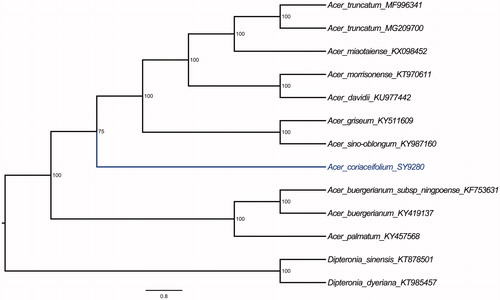Abstract
The complete chloroplast sequence of Acer coriaceifolium H. Lév., an ideal ornamental tree species that is attractive by its colorful fruits, was determined in this study. The plastome consists of 159,736 bp with a typical circular structure including double inverted repeats (IRs) 26,497 bp in length separated by a large single-copy (LSC) region of 87,770 bp and a small single-copy (SSC) region of 16,972 bp, respectively. It contained 130 genes, including 92 protein-coding genes, 30 transfer RNA genes, and 8 ribosomal genes. Furthermore, maximum likelihood phylogenomic analysis was performed based on complete plastomes of the Aceraceae, which supported close relationships between A. coriaceifolium and A. sino-oblongum, A. griseum, A. davidii, A. morrisonense, A. miaotaiense, A. truncatum.
The genus of Acer L. (Aceraceae) is dominant in the forests of the Northern Hemisphere. This genus contains approximately 129 species. Nearly, 100 species have been recorded in China, 61 of which are endemic (Xu et al. Citation2008). However, the infrageneric phylogeny, classification, and systematic positions of some species remain unclear for this genus (Lin et al. Citation2017). As plant chloroplast sequences can provide helpful information to reconstruct complex evolutionary relationships, they have been widely applied for species identification and phylogenetic analysis during the past years (Jansen et al. Citation2007; Moore et al. Citation2007; Parks et al. Citation2009; Ruhsam et al. Citation2015). The information of chloroplast genomes has been extensively applied in understanding plant genetic diversity and conservation genetics (Ye et al. Citation2014; Zhang et al. Citation2016). Acer coriaceifolium is native to Central and South China. It can be used as an ornamental tree in city garden and greening because of its brownish-yellow fruits and its natural population can grow in drying limestone habitats. The chloroplast genome of A. coriaceifolium will prominently advance the phylogenetic systematics of this genus.
In this study, we sequenced, assembled, and annotated the chloroplast genome of A. coriaceifolium using high throughput genome sequencing technology. Young, fresh, and healthy leaves of A. coriaceifolium were collected from a wild tree from Kunming Institute of Botany (KIB) Kunming, China (25.136°E, 102.745°N). The voucher specimen of A. coriaceifolium was deposited at the Biodiversity Research Group of Xishuangbanna Tropical Botanical Garden (Accession Number: XTBG-BRG-SY33299). Total genomic DNA was extracted using a modified CTAB method (Doyle and Doyle Citation1987). According to the Illumina’s protocol, the pair-end libraries were constructed and then sequenced using Hiseq2000 platform (produced By Ilumina Co, San Diego, USA) , obtaining 50.1 million high-quality clean reads. With A. miaotaiense (Zhang et al. Citation2016) as a reference, we assembled and annotated the cp genome using CLC Genomic Workbench v7.5 (CLC bio, Aarhus, Denmark; http://www.qiagenbioinformatics.com) and Dogma (https://dogma.ccbb.utexas.edu/), respectively. The annotated genomic sequence was deposited into the GenBank database under the accession number of SY9280. The complete chloroplast genome is 159,736 bp in size, containing a large single-copy region (LSC) of 87,770 bp, a small single copy region (SSC) of 16,972 bp, and a pair of 26,497 bp inverted repeat regions (IRs). The chloroplast genome harbours 130 genes, including 92 protein-coding genes, 30 tRNA genes, and 8 rRNA genes. The base composition is asymmetric with an overall GC content of 43.00%.
To determine the phylogenetic position of A. coriaceifolium, we constructed the phylogenetic tree between A. coriaceifolium and nine other plant species based on whole chloroplast genome sequences with maximum likelihood(ML) method using MEGA7 (Kumar et al. Citation2016) (). Acer coriaceifolium is closely related to other Acer species, including A. sino-oblongum, A. griseum, A davidii, A. morrisonense, A. miaotaiense, and A. truncatum, and they form a clade together with Dipteronia sinensis belonging to the family Aceraceae with a strong bootstrap value of 100%. The complete chloroplast genome of A. coriaceifolium will provide valuable genetic data for the subsequent systematic evolutionary and taxonomic study of Acer L.
Disclosure statement
The authors report no conflicts of interest. The authors are responsible for the data and writing of this paper.
Additional information
Funding
References
- Doyle JJ, Doyle JL. 1987. A rapid DNA isolation procedure for small quantities of fresh leaf tissue. Phytochem Bull. 19:11–15
- Jansen RK, Cai Z, Raubeson LA, Daniell H, Leebens-Mack J, Muller KF, Guisinger-Bellian M, Haberle RC, Hansen AK, Chumley TW, et al. 2007. Analysis of 81 genes from 64 plastid genomes resolves relationships in angiosperms and identifies genome-scale evolutionary patterns. Proc Natl Acad Sci USA. 104:19369–19374.
- Kumar S, Stecher G, Tamura K. 2016. MEGA7: molecular evolutionary genetics analysis version 7.0 for bigger datasets. Mol Biol Evol. 33:1870–1874.
- Lin L, Lin LJ, Zhu ZY, Ding YL, Kuai BK. 2017. Studies on the taxonomy and molecular phylogeny of Acer in China. Acta Horticulturae Sinica. 44:1535–1547.
- Moore MJ, Bell CD, Soltis PS, Soltis DE. 2007. Using plastid genome-scale data to resolve enigmatic relationships among basal angiosperms. Proc Natl Acad Sci USA. 104:19363–19368.
- Parks M, Cronn R, Liston A. 2009. Increasing phylogenetic resolution at low taxonomic levels using massively parallel sequencing of chloroplast genomes. BMC Biol. 7:84.
- Ruhsam M, Rai HS, Mathews S, Ross TG, Graham SW, Raubeson LA, Mei W, Thomas PI, Gardner MF, Ennos RA, et al. 2015. Does complete plastid genome sequencing improve species discrimination and phylogenetic resolution in Araucaria? Mol Ecol Resour. 15:1067–1078.
- Xu TZ, Chen YS, Piet C, d, Jong HJ, Oterdoom HJ, Chin SC. 2008. Aceraceae. in: Wu, Z.Y., Raven, P.H. & Hong, D.Y. (Eds.)Flora of China-Aceraceae. 11. Science Press, Beijing, 518–553.
- Ye C-Y, Lin Z, Li G, Wang Y-Y, Qiu J, Fu F, Zhang H, Chen L, Ye S, Song W, et al. 2014. Echinochloa chloroplast genomes: insights into the evolution and taxonomic identification of two weedy species. PLoS One. 9:e113657.
- Zhang Y, Li B, Chen H, Wang Y. 2016. Characterization of the complete chloroplast genome of Acer miaotaiense (Sapindales: Aceraceae), a rare and vulnerable tree species endemic to China. Conserv Genet Res. 8:1–3.

